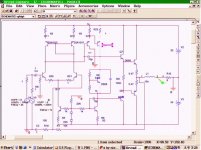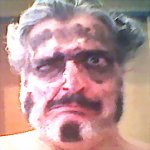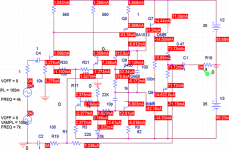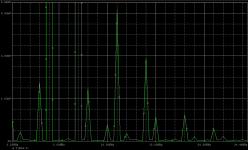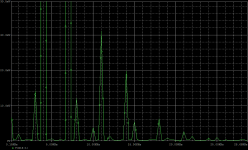Hi thanh,
for creating complex signals / adding signals, simply put the signalsources
in series...
This sums perfectly the signals !
Mike
for creating complex signals / adding signals, simply put the signalsources
in series...
This sums perfectly the signals !
Mike
thanh said:I cant know !
4k degeneration resistor distor more 1 ohm degeneration
Thanh,
have you used any other values between 1 ohm and 4 kohm??
And you have read Leech paper about diffpair degeneration?
Maybe best to sort out what is distorting, remove current mirror and look at the diffpair alone first to decide what gives what in your analyses.
Michael
Ok ! I will re-check
I found that degeneration resistors is not good .Amp will sound dirtier .My current amp dont use them but it still sound well
I found that degeneration resistors is not good .Amp will sound dirtier .My current amp dont use them but it still sound well
220 ohms works well as emitter degeneration. Currentmirrors gave me problems especially in a complementary diffamp configuration. A cascode is better. A useful side effect of using a cascode is you can use the zener regulated midpoint as your current source with only a resistor (which is lower noise, apparently)
I used to use degeneration resistor before . It can decrease the difference of transistors at input stage . Mikeb is too . And then Mikeb no longer use these resistor and I also try to do . Now I also no longer use it
Hi thanh,
You have been busy, but what have you done here? What I see is that you have reduced loop gain progressively by adding more and more emitter degen resistance and the IM distortion has increased. Why are you surprised?
This is more a win for global feedback than a fail for emitter degen. You see, while emitter degen will linearise, decrease the gain of, and increase the bandwidth of one local stage, it will also reduce the global NFB so it is less effective at reducing distortion elsewhere which may well be more prominent that the stage you're degenerating.
In effect you are robbing the amplifier of effective global NFB and depriving the stage which most needs correction - and coming to the wrong conclusions!
Hope this helps.
Cheers,
Greg
You have been busy, but what have you done here? What I see is that you have reduced loop gain progressively by adding more and more emitter degen resistance and the IM distortion has increased. Why are you surprised?
This is more a win for global feedback than a fail for emitter degen. You see, while emitter degen will linearise, decrease the gain of, and increase the bandwidth of one local stage, it will also reduce the global NFB so it is less effective at reducing distortion elsewhere which may well be more prominent that the stage you're degenerating.
In effect you are robbing the amplifier of effective global NFB and depriving the stage which most needs correction - and coming to the wrong conclusions!
Hope this helps.
Cheers,
Greg
Hi thanh !
I prefer REs for diffamp in the range 22-47ohms. You should make
tests in the range up to 100ohms. Using bigger values only result
in very low feedback which can introduce even more IM/THD.
Mike
I prefer REs for diffamp in the range 22-47ohms. You should make
tests in the range up to 100ohms. Using bigger values only result
in very low feedback which can introduce even more IM/THD.
Mike
Self discusses emitter degen in sec 5.1 of:
http://www.dself.dsl.pipex.com/ampins/dipa/dipa.htm
he points out that you can adjust tail current to keep diff pair gm constant as you change the emitter R (for a small range of emitter R, few people would try even 1 K emitter degen )
current mirror load assures diff pair current balance (up to a possible ib error) – without the current mirror you have to carefully adjust collector load R and vas bias to keep diff pair currents balanced as you adj tail current or change vas bias, additionally current mirrors provide a useful degree of even order distortion cancellation by differencing the diff pair collector currents – current mirrors are too useful to not use and they don’t significantly effect TIM/slew rate distortions (beyond the obvious doubling of diff pair’s effective gm)
You really shouldn’t expect improvement when you haven’t compensated for the lost loop gain as you add emitter degen
in http://www.diyaudio.com/forums/showthread.php?postid=501789#post501789 I show a sim that shows changing Ccomp to keep GBW (and loop gain) constant when changing diff pair gm for a “fair” comparision – when you do make a fair comparison degeneration of bjt diff pairs has clearly superior distortion performance
http://www.dself.dsl.pipex.com/ampins/dipa/dipa.htm
he points out that you can adjust tail current to keep diff pair gm constant as you change the emitter R (for a small range of emitter R, few people would try even 1 K emitter degen )
current mirror load assures diff pair current balance (up to a possible ib error) – without the current mirror you have to carefully adjust collector load R and vas bias to keep diff pair currents balanced as you adj tail current or change vas bias, additionally current mirrors provide a useful degree of even order distortion cancellation by differencing the diff pair collector currents – current mirrors are too useful to not use and they don’t significantly effect TIM/slew rate distortions (beyond the obvious doubling of diff pair’s effective gm)
You really shouldn’t expect improvement when you haven’t compensated for the lost loop gain as you add emitter degen
in http://www.diyaudio.com/forums/showthread.php?postid=501789#post501789 I show a sim that shows changing Ccomp to keep GBW (and loop gain) constant when changing diff pair gm for a “fair” comparision – when you do make a fair comparison degeneration of bjt diff pairs has clearly superior distortion performance
thanks all !very interesting post
I found that amp with current mirror is the best amp . Perhaps I try to re-build it
amplifierguru ! Which stage is the most needs correction ?
I found that amp with current mirror is the best amp . Perhaps I try to re-build it
amplifierguru ! Which stage is the most needs correction ?
Hi Thanh.
"Which stage is the most needs correction ?"
I hoped you wouldn't ask. Probably your output stage provided you have matching Vas emitter degen to that of the current source. The point was that global feedback corrects the worst while you could easily be degenerating the best and wasting that global feedback, so worsening distortion.
Cheers,
Greg
"Which stage is the most needs correction ?"
I hoped you wouldn't ask. Probably your output stage provided you have matching Vas emitter degen to that of the current source. The point was that global feedback corrects the worst while you could easily be degenerating the best and wasting that global feedback, so worsening distortion.
Cheers,
Greg
- Status
- Not open for further replies.
- Home
- Amplifiers
- Solid State
- I though that I mastered TIM
